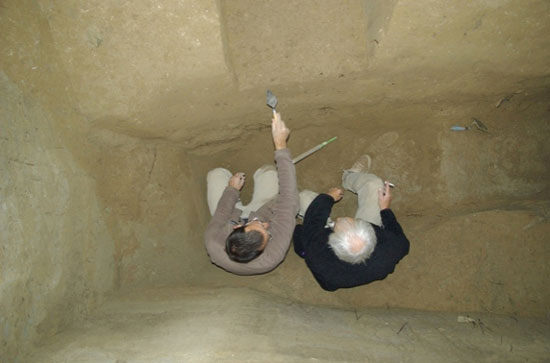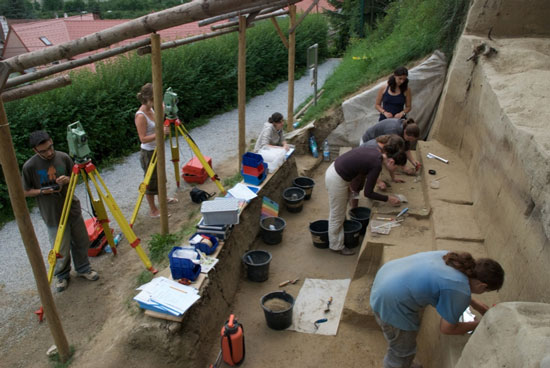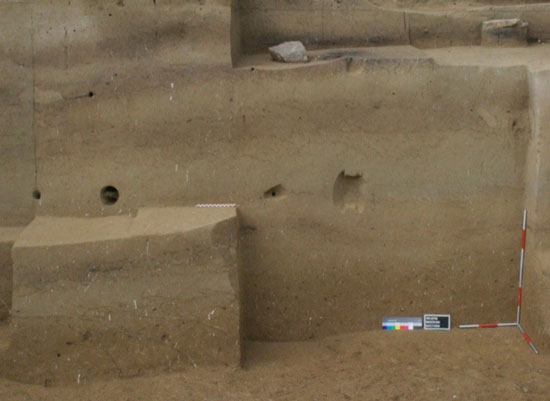
Early modern humans inhabited the region of what is today known as Austria around 43,500 years ago, living in an environment that was cold and steppe-like, according to a recent study.
Philip Nigst and colleagues of the Max Planck Institute for Evolutionary Anthropology and other institutions analyzed stone tools and their context after a re-excavation of the famous Willendorf site in Austria, the site best known for the discovery in 1908 of the Venus of Willendorf figurine. Between 2006 and 2011 archaeologists uncovered an assemblage of 32 lithic artifacts and 23 faunal remains. The authors identified the tools as belonging to the Aurignacian culture, generally accepted as associated with modern humans. The researchers determined this through systematic morphological and technological analysis. They assign the artifacts to a very early archaeological horizon of modern human occupation.
“By using stratigraphic, paleoenvironmental, and chronological data, AH 3 [the archaeological horizon assigned to this assemblage] is ascribed to the onset of Greenland Interstadial 11, around 43,500 cal B.P., and thus is older than any other Aurignacian assemblage,” wrote the study authors. “Most importantly,” the study authors continued, “for the first time to our knowledge, we have a high-resolution environmental context for an Early Aurignacian in Central Europe, demonstrating an early appearance of behaviorally modern humans in a medium-cold steppe-type environment with some boreal trees along valleys around 43,500 cal B.P.”*
_______________________________
Archaeologist Philip R. Nigst and geologist Paul Haesaerts in a test trench at Willendorf II. Credit: Image courtesy of The Willendorf Project, Philip R. Nigst and Bence Viola.
_______________________________
Excavations at Willendorf II. Credit: Image courtesy of The Willendorf Project, Philip R. Nigst and Bence Viola
_______________________________
Section at Willendorf II showing the succession of brown paleosols (medium-cold steppe environment) and yellow loess (cold periglacial steppe to deep frost environment). Holes in the section are sample holes. Credit: Image courtesy of The Willendorf Project, Philip R. Nigst and Bence Viola.
_______________________________
The age of the artifacts suggests that modern humans may have coexisted with Neanderthals in Europe for several thousand years, and the location of the assemblage in what was a cold and steppe-like environment over 43,000 years ago also suggests that early modern human settlers, who may have come from the warmer climate of southern Europe, were well-adapted to a variety of climates, according to the authors.
__________________________________________
*Article #14-12201: “Early modern human settlement of Europe north of the Alps occurred 43,500 years ago in a cold steppe-type environment,” by Philip R. Nigst et al.
Source: Adapted and edited from the abtract and excerpts of the in-press full document versions of the article*, to be published in the Journal of Human Evolution.
__________________________________________
Travel and learn with Far Horizons.
Read about the most fascinating discoveries with a premium subscription to Popular Archaeology Magazine. Find out what Popular Archaeology Magazine is all about. AND MORE:
On the go? Get the smartphone version of Popular Archaeology as an app or as an ebook.
Popular Archaeology’s annual Discovery Edition eBook is a selection of the best stories published in Popular Archaeology Magazine in past issues, with an emphasis on some of the most significant, groundbreaking, or fascinating discoveries in the fields of archaeology and paleoanthropology and related fields. At least some of the articles have been updated or revised specifically for the Discovery edition. We can confidently say that there is no other single issue of an archaeology-related magazine, paper print or online, that contains as much major feature article content as this one. The latest issue, volume 2, has just been released. Go to the Discovery edition page for more information.










